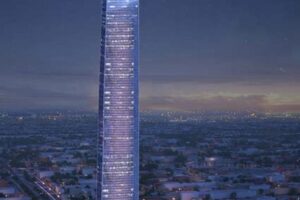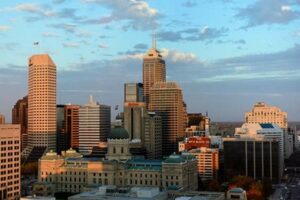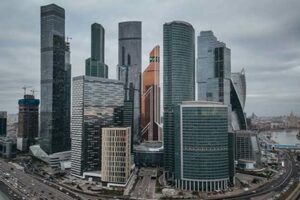A futuristic skyscraper city is an urban environment featuring towering skyscrapers that incorporate cutting-edge architectural designs and sustainable technologies. These cities represent a vision of the future where advanced infrastructure, innovative building techniques, and eco-friendly practices converge to create thriving and sustainable metropolises.
The importance of futuristic skyscraper cities lies in their potential to address the challenges of urbanization, such as population growth, resource scarcity, and environmental concerns. By maximizing vertical space and integrating green technologies, these cities can accommodate a large population while minimizing their ecological footprint. Additionally, they serve as hubs for technological advancements, fostering innovation and economic growth.
The concept of futuristic skyscraper cities has roots in the early 20th century, with visionary architects like Frank Lloyd Wright proposing designs for vertical cities. Today, cities like Dubai, Singapore, and Tokyo showcase impressive examples of futuristic skyscrapers, pushing the boundaries of architectural design and engineering.
1. Verticality
In the context of futuristic skyscraper cities, verticality plays a crucial role in maximizing space and creating sustainable urban environments. By building upwards, these cities can accommodate a large population without sprawling outwards, preserving valuable land for other purposes such as parks, green spaces, and infrastructure.
- Efficient Land Use: Skyscrapers allow cities to maximize the use of limited land, especially in densely populated areas. This efficient use of space reduces urban sprawl and helps preserve natural habitats.
- Reduced Environmental Impact: Vertical cities have a smaller environmental footprint compared to sprawling cities. By concentrating development upwards, they minimize land use, reduce transportation needs, and promote energy efficiency.
- Enhanced Density: Skyscrapers enable cities to accommodate a high population density within a compact area. This density supports vibrant urban communities, fosters social interaction, and reduces commuting times.
- Improved Infrastructure: Vertical cities facilitate the development of efficient infrastructure networks. By placing essential services and amenities within close proximity, skyscrapers enhance accessibility and convenience for residents.
Overall, verticality is a defining characteristic of futuristic skyscraper cities, allowing them to address the challenges of urbanization while creating sustainable and livable urban environments.
2. Sustainability
In the realm of futuristic skyscraper cities, sustainability takes center stage, guiding the design and operation of these urban environments to minimize their environmental impact and promote long-term livability. Eco-friendly designs and energy efficiency are key pillars of sustainability in these cities, manifesting in various facets:
- Green Building Practices: Futuristic skyscraper cities embrace green building practices that prioritize the use of sustainable materials, energy-efficient systems, and innovative technologies. This approach reduces the carbon footprint of buildings, conserves resources, and enhances indoor environmental quality.
- Renewable Energy Integration: These cities harness renewable energy sources such as solar and wind power to meet their energy needs. By incorporating solar panels, wind turbines, and geothermal systems into building designs, skyscrapers can generate clean energy, reducing reliance on fossil fuels.
- Water Conservation: Water scarcity is a growing concern in urban environments. Futuristic skyscraper cities implement water-saving technologies, such as rainwater harvesting systems, low-flow fixtures, and drought-tolerant landscaping, to conserve this precious resource.
- Waste Management: Sustainable waste management practices are essential in skyscraper cities. Advanced waste sorting and recycling systems minimize the amount of waste sent to landfills, promoting circularity and reducing environmental pollution.
By integrating these facets of sustainability into their design and operation, futuristic skyscraper cities strive to create a harmonious balance between urban development and environmental stewardship, ensuring a sustainable future for their inhabitants.
3. Technology
In the context of futuristic skyscraper cities, technology plays a pivotal role in creating smart and interconnected urban environments. Smart infrastructure and integrated systems form the backbone of these cities, enhancing efficiency, sustainability, and the overall quality of life for residents.
- Intelligent Transportation Systems: Futuristic skyscraper cities implement intelligent transportation systems that optimize traffic flow, reduce congestion, and improve commute times. These systems leverage sensors, cameras, and data analytics to monitor traffic patterns, adjust traffic signals in real-time, and provide real-time information to drivers.
- Smart Energy Grids: Smart energy grids enable skyscraper cities to manage energy consumption efficiently. These grids integrate renewable energy sources, such as solar and wind power, with traditional energy sources to meet demand while minimizing environmental impact. Smart meters and sensors monitor energy usage, allowing for optimized distribution and reduced waste.
- Building Automation Systems: Buildings within futuristic skyscraper cities are equipped with building automation systems that control and optimize various aspects of building operations. These systems manage lighting, heating, ventilation, and security, enhancing energy efficiency, occupant comfort, and overall building performance.
- Integrated Communication Networks: High-speed and reliable communication networks are essential for futuristic skyscraper cities. These networks provide seamless connectivity for residents, businesses, and devices, supporting remote work, e-commerce, and smart city applications.
By integrating these technological advancements, futuristic skyscraper cities create a foundation for sustainable, efficient, and interconnected urban living, where technology empowers residents and enhances their quality of life.
4. Density
In the context of futuristic skyscraper cities, density plays a crucial role in maximizing space, promoting sustainability, and fostering vibrant urban communities. By accommodating large populations in compact areas, skyscraper cities achieve several key benefits:
- Efficient Land Use: Density reduces urban sprawl, preserving valuable land for other purposes such as parks, green spaces, and essential infrastructure.
- Reduced Environmental Impact: Compact cities have a smaller carbon footprint compared to sprawling cities. Concentrating development upwards minimizes land use, reduces transportation needs, and promotes energy efficiency.
- Enhanced Social Interaction: Density fosters vibrant and diverse urban communities. By bringing people closer together, it encourages social interaction, collaboration, and a sense of belonging.
- Improved Accessibility: Dense skyscraper cities often have efficient public transportation systems that connect residents to essential services, amenities, and employment centers.
Real-life examples of futuristic skyscraper cities that embrace density include Hong Kong, Tokyo, and New York City. These cities have successfully implemented vertical development strategies to accommodate large populations while maintaining a high quality of life for their residents.
Understanding the connection between density and futuristic skyscraper cities is crucial for urban planners and policymakers seeking to create sustainable and livable urban environments. By promoting density, cities can maximize space, reduce environmental impact, foster community, and enhance accessibility, ultimately contributing to the success and well-being of their inhabitants.
5. Innovation
Futuristic skyscraper cities serve as hubs for technological advancements, fostering innovation and driving urban progress. This connection manifests in several key facets:
- Research and Development Centers: Skyscraper cities attract leading research institutions, universities, and corporate innovation labs. These centers collaborate on cutting-edge technologies, such as artificial intelligence, robotics, and sustainable materials, which are then tested and implemented within the city’s infrastructure.
- Startup Ecosystems: Futuristic skyscraper cities provide fertile ground for startups and entrepreneurs. Incubators, accelerators, and venture capital firms support the development and growth of innovative businesses, fostering a culture of experimentation and risk-taking.
- Smart City Initiatives: These cities embrace smart city initiatives that leverage technology to improve urban living. From intelligent transportation systems to data-driven urban planning, smart city projects enhance efficiency, sustainability, and quality of life for residents.
- Vertical Farming: Skyscraper cities explore vertical farming techniques to address food security and sustainability challenges. Vertical farms optimize space and controlled environments to produce fresh produce within urban areas, reducing transportation costs and environmental impact.
By nurturing innovation and technological advancements, futuristic skyscraper cities drive economic growth, create employment opportunities, and establish themselves as global centers of knowledge and progress. These cities act as testbeds for new technologies, shaping the future of urban living and contributing to a more sustainable and prosperous society.
6. Connectivity
In futuristic skyscraper cities, connectivity is paramount. Seamless transportation and communication networks are essential for the efficient functioning and overall livability of these dense urban environments. This connectivity manifests in various forms:
- Efficient Public Transportation: Skyscraper cities prioritize efficient public transportation systems, including subways, buses, and light rail networks. These systems enable residents to navigate the city quickly and conveniently, reducing traffic congestion and promoting sustainability.
- Integrated Transportation Hubs: Intermodal transportation hubs seamlessly connect different modes of transportation, such as airports, train stations, and bus terminals. These hubs facilitate easy transfers between public transportation, private vehicles, and other modes, enhancing accessibility and reducing commute times.
- Smart Traffic Management: Advanced traffic management systems leverage sensors, cameras, and data analytics to optimize traffic flow in real-time. This technology reduces congestion, improves road safety, and enhances the overall efficiency of the transportation network.
- Ubiquitous Broadband Connectivity: Futuristic skyscraper cities provide ubiquitous broadband connectivity through high-speed fiber optic networks and wireless technologies. This connectivity supports remote work, e-commerce, and smart city applications, fostering economic growth and improving the quality of life for residents.
Real-life examples of futuristic skyscraper cities that excel in connectivity include Tokyo, Singapore, and London. These cities have invested heavily in public transportation infrastructure, integrated transportation hubs, and advanced traffic management systems, resulting in efficient and interconnected urban environments.
Understanding the connection between connectivity and futuristic skyscraper cities is crucial for urban planners and policymakers. By prioritizing seamless transportation and communication networks, cities can enhance livability, reduce congestion, promote sustainability, and foster economic growth. Connectivity serves as the backbone of these cities, enabling them to function efficiently and adapt to the evolving needs of their residents.
7. Design
In the realm of futuristic skyscraper cities, design plays a pivotal role, shaping the visual identity, functionality, and overall experience of these urban environments. Visionary architectural concepts and aesthetics transcend mere aesthetics, becoming integral to the identity and success of these cities.
Futuristic skyscraper cities serve as canvases for architects and designers to push the boundaries of architectural expression. These cities showcase innovative building designs, experimental materials, and cutting-edge construction techniques. The skyscrapers that define these cities are not just tall structures but works of art, embodying the aspirations and values of their inhabitants.
The design of futuristic skyscraper cities prioritizes functionality and sustainability. Buildings are designed to maximize space, optimize energy efficiency, and incorporate green features to reduce their environmental impact. Vertical gardens, rooftop terraces, and natural ventilation systems are common elements, creating healthier and more sustainable living spaces.
Real-life examples of futuristic skyscraper cities that excel in design include Dubai, Shanghai, and Seoul. These cities have attracted world-renowned architects to design iconic structures that have become landmarks and symbols o
f innovation. The Burj Khalifa in Dubai, the Shanghai Tower in China, and the Lotte World Tower in Seoul are testaments to the power of visionary design in shaping futuristic skyscraper cities.
Understanding the connection between design and futuristic skyscraper cities is crucial for urban planners, architects, and policymakers. By embracing visionary architectural concepts and aesthetics, cities can create unique and sustainable urban environments that enhance the quality of life for their residents and become symbols of progress and innovation.
FAQs on Futuristic Skyscraper Cities
This section addresses frequently asked questions and misconceptions surrounding futuristic skyscraper cities, providing concise and informative answers.
Question 1: Are futuristic skyscraper cities environmentally sustainable?
Yes, futuristic skyscraper cities can be designed to be environmentally sustainable. They incorporate green building practices, energy-efficient systems, and renewable energy sources to minimize their carbon footprint and promote sustainability.
Question 2: How do skyscraper cities address overpopulation?
Skyscraper cities maximize space through vertical development, allowing them to accommodate large populations in compact areas. This reduces urban sprawl and preserves valuable land for other purposes.
Question 3: Are skyscraper cities affordable for residents?
Affordability in skyscraper cities varies depending on factors such as location, building design, and government policies. Some cities implement measures such as rent control and affordable housing programs to ensure accessibility for a diverse range of residents.
Question 4: How do skyscraper cities handle transportation challenges?
Futuristic skyscraper cities prioritize efficient transportation systems, including public transportation, integrated transportation hubs, and smart traffic management. These systems reduce congestion, improve commute times, and promote sustainability.
Question 5: Are skyscraper cities safe and secure?
Skyscraper cities implement advanced safety and security measures, including building codes, fire safety systems, and surveillance technologies. These measures ensure the well-being and security of residents.
Question 6: How do skyscraper cities promote social interaction?
Skyscraper cities foster social interaction through public spaces, community events, and mixed-use developments that bring together residents from diverse backgrounds.
In summary, futuristic skyscraper cities offer innovative solutions to urban challenges, combining sustainability, efficiency, and livability. They represent a vision for the future of urban living, where technological advancements and visionary design create thriving and sustainable communities.
Transition to the next article section:
Tips for Futuristic Skyscraper Cities
As cities around the world embrace vertical living, futuristic skyscraper cities offer a glimpse into the future of urban design and sustainability. By implementing these tips, urban planners and architects can create thriving and livable skyscraper cities.
Tip 1: Prioritize Sustainability
Incorporate green building practices, energy-efficient systems, and renewable energy sources to minimize the environmental impact of skyscraper cities. This includes using sustainable materials, optimizing energy consumption, and promoting waste reduction.
Tip 2: Maximize Space through Vertical Development
Utilize vertical space efficiently to accommodate a large population without sprawling outwards. Encourage mixed-use developments that combine residential, commercial, and green spaces within the same skyscraper.
Tip 3: Implement Smart Infrastructure
Integrate smart technologies into the city’s infrastructure to improve efficiency, sustainability, and quality of life. This includes intelligent transportation systems, smart energy grids, and automated building management systems.
Tip 4: Foster Connectivity and Accessibility
Provide seamless transportation networks, including public transportation, bike lanes, and pedestrian-friendly streets. Create integrated transportation hubs to facilitate easy transfers between different modes of transportation.
Tip 5: Promote Inclusivity and Affordability
Implement policies and programs to ensure that skyscraper cities are accessible and affordable for a diverse range of residents. This includes providing affordable housing options, promoting social equity, and encouraging community engagement.
Tip 6: Encourage Innovation and Design
Support innovative architectural concepts and cutting-edge building technologies. Create incentives for architects and developers to push the boundaries of design and sustainability.
Tip 7: Prioritize Safety and Security
Implement comprehensive safety and security measures, including building codes, fire safety systems, and surveillance technologies. Ensure that skyscraper cities are designed to withstand natural disasters and other emergencies.
Tip 8: Foster a Sense of Community
Create public spaces, community centers, and green areas to encourage social interaction and a sense of belonging among residents. Promote community events and activities to bring people together.
By following these tips, cities can harness the potential of futuristic skyscraper cities to create sustainable, livable, and thriving urban environments for the future.
Futuristic Skyscraper Cities
Futuristic skyscraper cities represent a transformative vision for urban living, addressing the challenges of urbanization while creating sustainable and livable environments. By embracing vertical development, smart infrastructure, and innovative design, these cities offer a glimpse into the future of urban design and sustainability.
The exploration of futuristic skyscraper cities highlights the importance of sustainable practices, efficient land use, seamless connectivity, and fostering a sense of community. As cities around the world continue to grow, the concepts and technologies developed for skyscraper cities can serve as valuable tools for creating thriving and sustainable urban environments. By embracing the potential of vertical living, we can shape the future of cities to be more livable, sustainable, and equitable for all.







